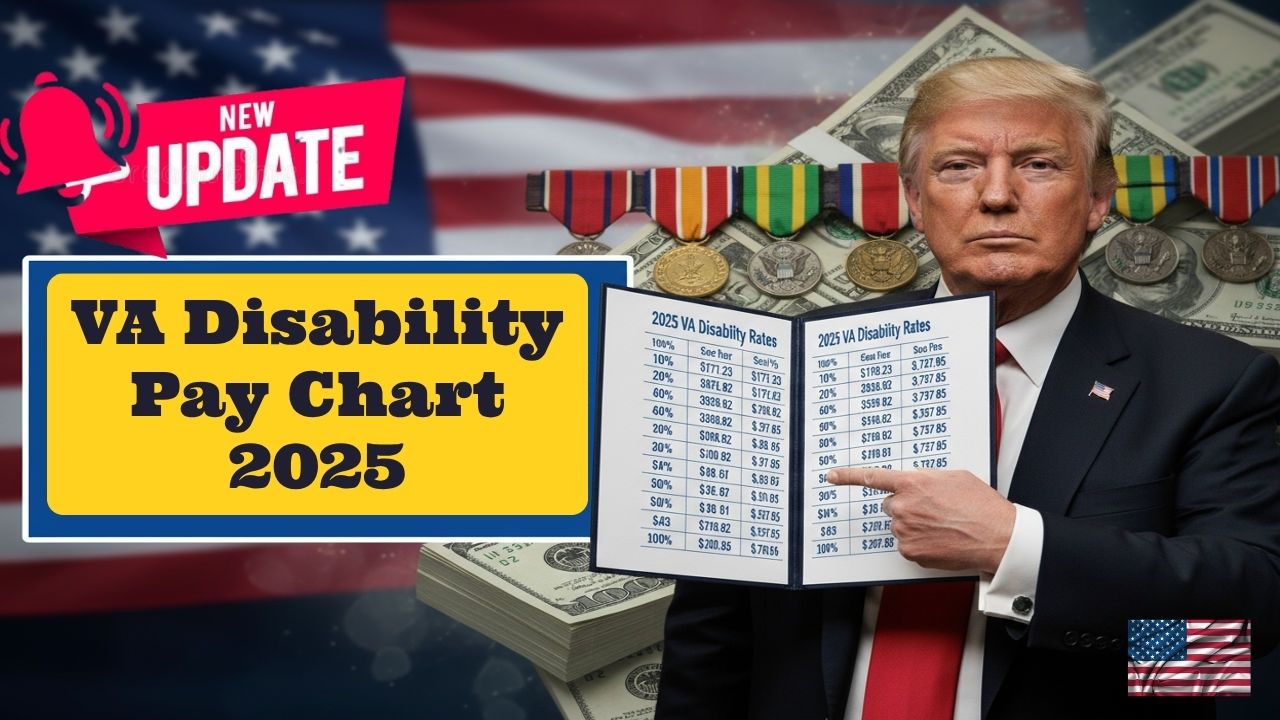The VA has published the 2025 disability compensation updates with a 2.5% cost of living adjustment effective from 1 December 2025. This guide explains how the new rates work, who qualifies, how to file or increase a claim, and how to avoid common delays so veterans and families receive the full benefits they have earned.
VA Disability Pay Chart 2025 Quick Summary
Item |
Details |
|---|---|
Authority |
U.S. Department of Veterans Affairs |
Program |
VA Disability Compensation Program |
COLA for 2025 |
2.5% effective 1 December 2025, reflected in January payments |
Rating range |
10% to 100% in 10 point increments, with special provisions for TDIU |
Payment frequency |
Monthly by direct deposit or mailed check |
Who qualifies |
Veterans with service connected disabilities, and in some cases dependents of disabled or deceased veterans |
Official site link |
What Is VA Disability Compensation
VA disability compensation is a federal, tax free monthly payment for veterans whose illnesses or injuries were caused or aggravated by active duty service. The VA assigns a disability rating from 10% to 100% based on medical evidence and impact on daily functioning. Ratings can be combined when a veteran has multiple service connected conditions. Payments increase with higher ratings and may include additional amounts for qualified dependents.
Common service connected conditions include PTSD, hearing loss and tinnitus, respiratory or cardiac issues, musculoskeletal injuries, migraine, traumatic brain injury, and exposure related conditions. The VA bases decisions on service treatment records, civilian medical records, Compensation and Pension exams, and legal standards in Title 38.
2025 COLA Increase
The 2025 cost of living adjustment is 2.5%. This adjustment raises all monthly compensation rates so buying power keeps pace with inflation in areas like rent, food, transportation, and health costs. The effective date is 1 December 2025 and the first payment that reflects the increase typically arrives in early January.
2025 VA Disability Pay Chart
Your monthly amount depends on your combined rating and dependency status. Below are sample values that reflect the 2025 update mentioned in the brief. Always verify your exact rate on the official VA page after the annual tables are posted.
10% to 20% with no dependents
Disability percentage |
2025 monthly payment |
|---|---|
10% |
$175.51 |
20% |
$346.95 |
30% to 60% with children
Amounts vary by dependent configuration. Examples:
Dependent status |
30% |
40% |
50% |
60% |
|---|---|---|---|---|
Veteran with 1 child only |
579.42 |
831.16 |
1,173.04 |
1,480.93 |
With 1 child and spouse |
648.42 |
922.16 |
1,287.04 |
1,617.93 |
With 1 child, spouse, 1 parent |
699.42 |
990.16 |
1,372.04 |
1,719.93 |
With 1 child, spouse, 2 parents |
750.42 |
1,058.16 |
1,457.04 |
1,821.93 |
With 1 child, 1 parent |
630.42 |
899.16 |
1,258.04 |
1,582.93 |
With 1 child, 2 parents |
681.42 |
967.16 |
1,343.04 |
1,684.93 |
Notes that help
- At 30% and above, additional amounts may be payable for a spouse, children, and dependent parents.
- Special monthly compensation, housebound, and aid and attendance can further increase payments when criteria are met.
- Ratings of 70%, 80%, 90%, and 100% will have higher corresponding tables. Check the VA site for the full chart.
Eligibility Basics
You may qualify if you served on active duty, active duty for training, or inactive duty training and you have a current disability related to service. To prove service connection, veterans usually show a current diagnosis, an in service event, and a medical nexus linking the two. Some conditions are presumptive based on locations, exposures, or time periods, which can simplify the nexus requirement.
Dependency recognition matters once your combined rating reaches 30% or higher. The VA can add amounts for a spouse, dependent children, and sometimes parents who rely on the veteran for support.
How To Apply For VA Disability Benefits
- Create or sign in to your VA account and start a claim at VA.gov.
- Complete VA Form 21 526EZ and list every claimed condition.
- Upload evidence such as service treatment records, private medical records, and lay statements.
- Respond to VA exams and evidence requests quickly.
- Track claim status in your VA dashboard and keep copies of all submissions.
- After a decision, review the rating and effective dates. If you disagree, you may file a Supplemental Claim, Higher Level Review, or Board Appeal.
If you need help, contact a Veterans Service Officer from organizations such as DAV, VFW, American Legion, or your state veterans agency. VSOs offer no cost assistance and understand the evidence needed for success.
Ways To Maximize Your Rating Legally
- Ask your clinician to complete disability benefits questionnaires that address the rating criteria.
- Submit lay statements that describe frequency, severity, and functional limits in plain language.
- Document flare ups, work impact, and activities you can no longer perform.
- If conditions have worsened, request an increase with up to date medical evidence.
- Consider TDIU if service connected conditions prevent substantially gainful employment, even when the combined schedular rating is below 100%.
Payments, Timing, and Back Pay
- Payments arrive monthly, usually on the first business day of the month for the prior month’s entitlement.
- Direct deposit is fastest. Set it up in your VA profile.
- If the VA grants service connection with a past effective date, you will receive retroactive back pay in a lump sum.
- Some benefits coordinate with Social Security and military retired pay. CRDP and CRSC rules can affect the final net amount for military retirees.
When To Request A Review
- Your condition has worsened or you have new complications.
- You discover new medical evidence or a favorable nexus opinion.
- The VA recognizes new presumptive conditions that fit your service history.
- You identify a clear error in the decision. Use the chosen review lane within the decision notice deadlines.
Documents Checklist
- Service treatment records and separation documents
- Private medical records and test results
- DBQs, nexus letters, or specialist opinions
- Marriage certificate, birth certificates, or school certification for dependents as needed
- Banking details for direct deposit
Frequently Asked Questions
1. How is a VA disability rating determined
By the medical severity of each service connected condition against the VA Schedule for Rating Disabilities, then combined into a single rating using the VA combined ratings method.
2. Can dependents receive VA disability benefits
Yes. At 30% and above, additional amounts may be paid for a spouse, dependent children, and in some cases dependent parents. Survivors may qualify for separate programs such as DIC.
3. Where do I check my claim status
Log in to your account at VA.gov to view updates, upload documents, and read decision letters.
4. What if my condition worsens after I am rated
File for an increase with updated medical evidence. The VA may schedule a new exam to assess current severity.
5. What is TDIU and who qualifies
Total Disability based on Individual Unemployability pays at the 100% rate if service connected conditions prevent substantially gainful employment. There are schedular and extraschedular paths depending on your ratings and work history.
Conclusion
The 2025 VA disability update applies a 2.5% COLA and maintains the structured approach to rating and payment for service connected conditions. By understanding the tables, documenting medical severity, and keeping your dependency information current, you can protect your monthly compensation and secure back pay when it is due. Use the online tools at VA.gov, work with a trained VSO when needed, and keep records organized so you receive the full benefit of your earned entitlements.
For More Information Click Here








